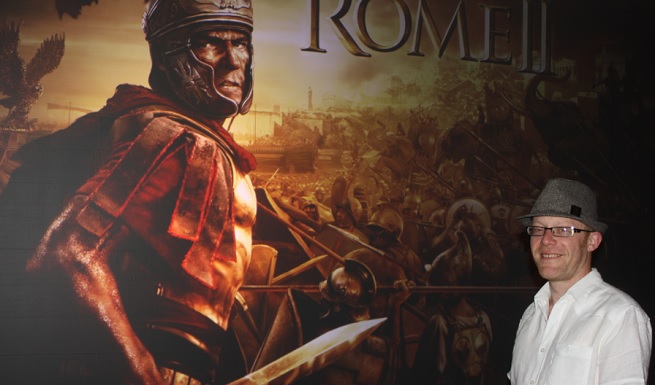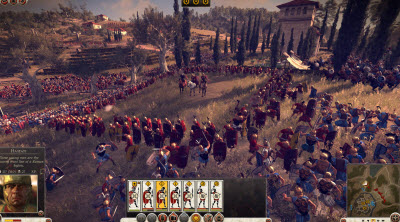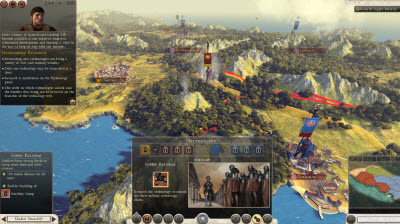Strategy game fans will be delighted to get the biggest Total War game yet on Sept. 3. After years of waiting, fans can expect a big game in Sega‘s Total War: Rome II, which combines a turned-based strategy campaign akin to Civilization with real-time brawls between the armies of the ancient Roman empire and its foes.
We got another preview of the game last week and talked with Al Bickham, the communications manager for Sega’s The Creative Assembly studio. He told us what to expect about the combined strategy and tactical focus and just how smart you can expect the enemies to be. We played a few battles, and it was a small slice of what is in the full game. This game feels epic in its scope and visceral in the way that it depicts the vicious hand-to-hand combat of swords, spears, and horses.
The scale of the The Creative Assembly’s ambition is huge. It has more than 700 units, compared to just 50 in Total War: Shogun 2 from 2011. The campaign map is about four times larger than the previous game, depicting every territory from Scotland to the Horn of Africa. The A.I. makes better educated guesses about how to counter your expansion strategy, he said. And when your armies meet on the realistic map, the conflict zooms in on the forces as they engage in a real-time tactical battle.
“It’s been a titanic effort,” Bickham said. “We crossed our own personal Rubicon.”
Total War: Rome II captures historical periods like Hannibal’s wars against Rome, but once you take control of it, you start making your own history.
Here’s an edited transcript of our interview with Bickham.
GamesBeat: Tell me some of those stats about how big the world is.
Bickham: The campaign map is about four times the size of Shogun II’s. It stretches from Portugal, the coast of the Iberian peninsula, over to Afghanistan, and then north to south it’s from the northernmost tip of Scotland to the Horn of Africa. It’s pretty big. In terms of factions, you have nine playable factions across three cultural types: barbarian, Greco-Roman and Mediterranean, and then eastern kingdoms as well, which have a very different look and feel, very different units to field.
We have around 700 battlefield units to recruit, including mercenaries. Wherever you are in the world, even if you’re not back in your home territory, you can always recruit mercenaries, which will be relevant to the local area. If you’re playing as one of the Germanic barbarian tribes and you’ve conquered your way down to Africa, you could hire some war elephants or camel riders. By comparison, we had only around 50 units when Shogun II initially released, and they were all very similar, because of course it’s a single culture, with just a few minor variances. It’s big.
The important thing is, it does sound a bit daunting. “How am I going to deal with all that?” But you can play a game of Rome II just in one little corner of the world. Just because you’re playing campaign doesn’t mean you have to conquer the whole campaign map. We have a number of different victory conditions to reflect that. You can still have military victories where you conquer a certain number of territories. But we also have two new victory types as well. You can play for a cultural victory. You can try to flip other cultures to follow your own and conquer through cultural expansion. You can also play for an economic victory, a series of economic milestones you have to get through. That introduces a different method of play for Total War, which has always been about conquest.
GamesBeat: Does it feel like laying a Civilization game over that military element?
Bickham: It’s about bringing a sense of variety, giving people more interesting choices to make. Any strategy game — any game, really – is about presenting the player with a series of interesting choices and challenges. We wanted to broaden that with Rome II.
It is still a Total War game. You might want to play for cultural victory, but you’ll still fight battles. You still have diplomacy to deal with. Enemy factions will still say, “I don’t like the way you’re expanding like this. I’m scared of you. I’m going to knock you down before you get too big.”
GamesBeat: How granular is the strategic map? If two armies meet, will you go to battle in a tactical map that is an accurate reflection of where they are on the strategic map?
Bickham: More so than we’ve done in any game before. We have a new terrain map hidden underneath the campaign map as you see it in the turn-based part of the game. The terrain generation system looks at any point on the map. When we have a battle on the map, you’ll see that landscape reflected. It’s essentially a giant battle map under the campaign map. When you dive in there, you’ll fight over that bit.
The next turn, you might fight another battle that’s only a couple of miles away from the battle you just had. You’ll see the same terrain features in the distance. If you’re fighting next to the Pyramids, you’ll see them on the outfield of the battle. If you fight a bit further down the Nile, you’ll see them in the distance. It’s incredibly detailed, incredibly granular, the way we generate battlefields based on where you are in the world.
We’re bringing that into multiplayer as well. It’s one of the exciting things about multiplayer matches. You have a representation of the campaign map in multiplayer, even if you’re just playing one-on-one with a friend or someone online. The host can click on that map and it will generate a battlefield from that part of the campaign map. If you find a really cool battlefield there, you can mark it as a favorite and save it for later. We’ll provide a set series of battlefields in multiplayer, but you can also go and find your own.
GamesBeat: Is there a trick to that? Instead of creating an entire battle map underneath there, are you generating sections of it and reusing some things?
Bickham: Certain parts of it are auto-generated. Things like shrubbery, foliage, that sort of thing. The key is the height map, the terrain map underneath that tells you where mountains and lakes and things like that are.
The whole thing has been an enormous amount of work. This is the most ambitious thing we’ve ever done. We’ve changed or improved so many of the core systems. Veteran players are going to be pleasantly surprised, I think, by how much more there is.
GamesBeat: How smart is the enemy now? What sort of behaviors do you see when you’re facing off against the A.I.?
Bickham: There are two strands to the A.I.: faction A.I., or campaign A.I., and battle A.I. On the campaign front, we’ve made some changes to the subtlety with which the AI reasons about the allies and opponents around it. It looks at relationships further away from itself. It looks at its opponent’s allies and its allies’ opponents. It draws a clearer picture of what’s going on in the world and makes more reasoned judgments – who it’s going to conduct war with, who it wants to make alliances and trade agreements with.
On the battle side, the big challenge has been—cities are very different. We have streets and alleys and big squares in the middle of cities and walls that you have to knock down. Since the original Rome, the AI has undergone a number of major revisions over time to improve the way it fights. Right now, if you play Shogun II, you’ll see that it’s in a good place. The AI does smart stuff in battle. It knows how to flank you. It looks to counter units with the right units.
GamesBeat: That was one of the flaws in past games, I thought. You could almost always defeat an A.I. unit by using two of your own to flank it. I rarely saw them do that to me.
Bickham: Right. That’s a core tactic of this kind of ancient warfare stuff — if you send the right unit up front that can stick around and hold the enemy long enough to hit it in the flank. Now, the AI looks to protect its flanks much better. If it has a bunch of infantry in front, and you’re obviously sending your cavalry around the flank, it’ll look to bring its spearmen out and protect the flank, because of course horsemen are very ill-advised to run at men with long sticks that have pointy ends. [laughs]
The way the player can exploit the landscape around him has changed, because we have a line of sight system. If you’re very cagey about the way you move your troops through terrain, you can hide them in woods now. If the AI doesn’t know it’s there and you set that up early, you have a flanking force. You draw the AI in with your main army and then send your flanking forces in. That’s going to be a good challenge for the AI.
We’ve thrown in a designed element of gutsiness as well. If the AI did exactly the right thing every single time, you wouldn’t be able to win. We introduce a level of variance. Some battle AI are more gutsy, more aggressive. Some are more defensive. It looks to make the best use of its forces, all the time.



